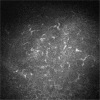Long-lasting corneal endothelial graft rejection successfully reversed after dexamethasone intravitreal implant
- PMID: 27468251
- PMCID: PMC4946863
- DOI: 10.2147/IMCRJ.S107926
Long-lasting corneal endothelial graft rejection successfully reversed after dexamethasone intravitreal implant
Abstract
Graft rejection is the most significant complication corneal transplantation and the leading indication for overall corneal transplantation. Corticosteroid therapy represents the mainstay of graft rejection treatment; however, the optimal route of administration of corticosteroid remains uncertain. We report herein for the first time the multimodal imaging of a case of long-lasting corneal endothelial graft rejection successfully reversed 3 months after dexamethasone intravitreal implant. A 29-year-old Asian female presented with a long-lasting corneal endothelial graft rejection in her left phakic eye. She underwent penetrating keratoplasty for advanced keratoconus 24 months before presentation. Hourly dexamethasone eyedrops, daily intravenous methylprednisolone, and one parabulbar injection of methylprednisolone acetate were administered during the 5 days of hospitalization. However, the clinical picture remained approximately unchanged despite therapy. By mutual agreement, we opted for the off-label injection of dexamethasone 0.7 mg intravitreal implant in order to provide therapeutic concentrations of steroid for a period of ~6 months. No other concomitant therapies were prescribed to the patient. Visual acuity measurement, slit lamp biomicroscopy, anterior segment photography, confocal microscopy, anterior segment optical coherence tomography, laser cell flare meter, intraocular pressure measurement, and ophthalmoscopy were performed monthly for the first postoperative 6 months. Three months after injection, both clinical and subclinical signs of rejection disappeared with a full recovery of visual acuity to 20/30 as before the episode. Currently, at the 12-month follow-up visit, the clinical picture remains stable without any sign of rejection, recurrence, or graft failure. Dexamethasone intravitreal implant seems to be a new potential effective treatment for corneal graft rejection, particularly in case of poor compliance or lack of response to conventional treatment. In addition, it could be especially useful in diabetic patients unable to receive systemic steroids.
Keywords: confocal microscopy; corneal graft rejection; dexamethasone intravitreal implant; keratoconus; keratoplasty.
Figures





Similar articles
-
Long-term resolution of immunological graft rejection after a dexamethasone intravitreal implant.Cornea. 2015 Apr;34(4):471-4. doi: 10.1097/ICO.0000000000000391. Cornea. 2015. PMID: 25742389
-
Presumed corneal stromal graft rejection after deep anterior lamellar keratoplasty in a patient with systemic lupus erythematosis.Eye Contact Lens. 2010 Nov;36(6):371-3. doi: 10.1097/ICL.0b013e3181f6bdc2. Eye Contact Lens. 2010. PMID: 20935566
-
Long-term comparison of full-bed deep lamellar keratoplasty with penetrating keratoplasty in treating corneal leucoma caused by herpes simplex keratitis.Am J Ophthalmol. 2012 Feb;153(2):291-299.e2. doi: 10.1016/j.ajo.2011.07.020. Epub 2011 Oct 13. Am J Ophthalmol. 2012. PMID: 21996306
-
Stromal rejection after big bubble deep anterior lamellar keratoplasty: case series and review of literature.Eye Contact Lens. 2013 Mar;39(2):194-8. doi: 10.1097/ICL.0b013e31824ccb91. Eye Contact Lens. 2013. PMID: 23392301 Review.
-
[New diagnostic methods for imaging the anterior segment of the eye to enable treatment modalities selection].Nippon Ganka Gakkai Zasshi. 2011 Mar;115(3):297-322; discussion 323. Nippon Ganka Gakkai Zasshi. 2011. PMID: 21476312 Review. Japanese.
Cited by
-
Antibody-mediated rejection in xenotransplantation: Can it be prevented or reversed?Xenotransplantation. 2023 Jul-Aug;30(4):e12816. doi: 10.1111/xen.12816. Epub 2023 Aug 7. Xenotransplantation. 2023. PMID: 37548030 Free PMC article. Review.
-
Intravitreal Dexamethasone Implant as a Sustained Release Drug Delivery Device for the Treatment of Ocular Diseases: A Comprehensive Review of the Literature.Pharmaceutics. 2020 Jul 26;12(8):703. doi: 10.3390/pharmaceutics12080703. Pharmaceutics. 2020. PMID: 32722556 Free PMC article. Review.
References
-
- Williams KA, Esterman AJ, Bartlett C, Holland H, Hornsby NB, Coster DJ. How effective is penetrating corneal transplantation? Factors influencing long-term outcome in multivariate analysis. Transplantation. 2006;81(6):896–901. - PubMed
-
- Naacke HG, Borderie VM, Bourcier T, Touzeau O, Moldovan M, Laroche L. Outcome of corneal transplantation rejection. Cornea. 2001;20(4):350–353. - PubMed
-
- Costa DC, de Castro RS, Kara-Jose N. Case-control study of subconjunctival triamcinolone acetonide injection vs intravenous methylprednisolone pulse in the treatment of endothelial corneal allograft rejection. Eye (Lond) 2009;23(3):708–714. - PubMed
-
- Maris PJ, Jr, Correnti AJ, Donnenfeld ED. Intracameral triamcinolone acetonide as treatment for endothelial allograft rejection after penetrating keratoplasty. Cornea. 2008;27(7):847–850. - PubMed
Publication types
LinkOut - more resources
Full Text Sources
Other Literature Sources

